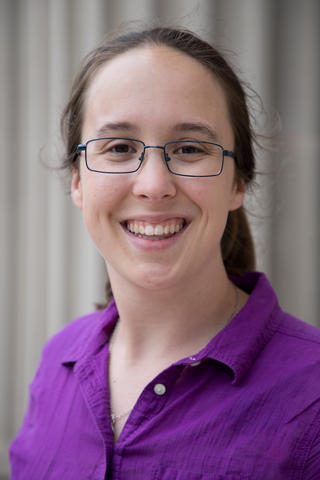
Carrie Sheeler
Thesis Title:
Mutant ATXN1 disrupts cellular and molecular pathways in a human iPSC-derived
Current Position:
Recent Graduate
Undergraduate Institution and Major:
College of William Mary, B.S. in Neuroscience/Chemistry, 2014
Graduate Advisors:
Marija Cvetanovic, Ph.D., Department of Neuroscience
Harry Orr, Ph.D., Department of Laboratory Medicine and Pathology
Description of Graduate Research:
My thesis project is the characterization of spinocerebellar ataxia type 1 (SCA1) in specific cell types. I am using induced pluripotent stem cells as a model to create neurons from different regions of the brain- cortical neurons, cervical lower motor neurons, and Purkinje neurons. Using this model, we seek to determine the effect of mutant Ataxin1 on the transcription, morphology, and function of these cells.
Graduate Publications:
- DNF is altered in a brain-region specific manner and rescues deficits in Spinocerebellar Ataxia Type 1. Neurobiol Dis. 2023 Mar;178:106023.
- Single nuclei RNA sequencing investigation of the Purkinje cell and glial changes in the cerebellum of transgenic Spinocerebellar ataxia type 1 mice. Front Cell Neurosci. 2022 Nov 15;16:998408.
- Spatial and temporal diversity of astrocyte phenotypes in spinocerebellar ataxia type 1 mice. Cells. 2022 Oct 21;11(20):3323.
- Sheeler C, Rosa JG, Borgenheimer E, Mellesmoen A, Rainwater O, Cvetanovic M. Post-symptomatic delivery of brain-derived neurotrophic factor (BDNF) ameliorates spinocerebellar ataxia type 1 (SCA1) pathogenesis. Cerebellum. 2021 Jun;20(3):420-429.
- Sheeler C, Rosa JG, Ferro A, McAdams B, Borgenheimer E, Cvetanovic M. Glia in neurodegeneration: The housekeeper, the defender and the perpetrator. Int J Mol Sci. 2020 Dec 2;21(23):9188.
- Ferro A, Sheeler C, Cvetanovic M. Microglial self-recognition STINGs in A-T neurodegeneration. Trends Neurosci. 2019;42(11):753-755.
- Mellesmoen A, Sheeler C, Ferro A, Rainwater O, Cvetanovic M. Brain derived neurotrophic factor (BDNF) delays onset of pathogenesis in transgenic mouse model of apinocerebellar ataxia type 1 (SCA1). Front Cell Neurosci. 2019 Jan 21;12:509.
- Ferro A, Sheeler C, Rosa JG, Cvetanovic M. Role of microglia in ataxias. J Mol Biol. 2019;431(9):1792-1804.
Graduate Level Abstracts:
- Sheeler CA, Cvetanovic M, Orr HT. Characterization of SCA1 in hiPSC-derived neural progenitors and neurons. Wellcome Genome Campus Course on Molecular Neurodegeneration. January 2019.
Graduate Awards:
- Stark Award for Advanced Scholarship, 2018
Professional Outreach:
- Saturday with a Scientist 2018
- Brain Awareness Week 2017, 2018
- Brain Bee 2017
Professional Societies:
- American Associate for the Advancement of Science (AAAS)
- American Chemical Society (ACS)
- Psi Chi
Thesis Committee Members:
Lucy Vulchanova, Ph.D., Department of Neuroscience (Chair)
Marija Cvetanovic, Ph.D., Department of Neuroscience
Harry Orr, Ph.D., Department of Department of Laboratory Medicine and Pathology
Patrick Rothwell, Ph.D., Department of Neuroscience
Yasushi Nakagawa, M.D. Ph.D., Department of Neuroscience
Rotations:
Karen Mesce, Ph.D., Department of Entomology
Nicola Grissom, Ph.D., Department of Psychology
Marija Cvetanovic, Ph.D., Department of Neuroscience
Undergraduate Awards:
Dean’s List, Fall 2010, Spring and Fall 2011, Fall 2012, Fall 2013, Spring 2014
Undergraduate or Post-Bac Research:
Undergraduate: Mathematical modeling of molecular system interaction in the progression of Multiple Sclerosis
Intramural Post-Baccalaureate Trainee at the NIH (NIMH): (1) Rates of protein synthesis in sleep consolidation and in Fragile X Syndrome. (2) The effect of metformin treatment and PDE4D inhibitor treatment on the underlying rates of protein synthesis and behavioral outcomes in fmr1 KO mice.
What Got You Interested In Research?
I was assigned a personal research project in high school AP Chemistry that brought me in a roundabout way to Neuroscience and the biochemistry behind psychological and neurodegenerative disorders. I found it absolutely fascinating and was excited by how much still remains to be discovered. I knew basically at that point that Neuroscience, and inevitably research, was where I was going to end up. The more research I do, the more I love it.
Why Did You Choose MN?
I loved the location, the research opportunities, and - perhaps most of all - the people.
Student Mentor and the Best Advice They Gave:
Natalie Steenrod: She really put me at ease. She’s very warm and welcoming.
Favorite Itasca Memory:
My favorite Itasca memory is a tie between group movie sessions, week 3 (pharmacology) group presentations, and Chloe's birthday, when we got everyone to go out on the lake together for an hours-long float/paddle, and Armani and I spent 4 hours in a canoe talking in pirate voices.
